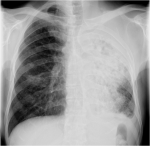You have just seen a 45 year old male with a predominant history of left upper chest pain and shoulder pain which has been keeping him awake at nights for many weeks.
On further questioning, he admits to having dyspnoea. He is a chronic smoker with a 20 pack year smoking history. You decide to get a chest x-ray and the x-ray is here. What is your diagnosis?
[peekaboo_link name=”Answer”] Answer[/peekaboo_link] [peekaboo_content name=”Answer”]The x-ray looks alarming to say the least.
There is a mass like consolidation in the left upper lobe with patchy areas of transluceny. The heart is shifted to the left (volume loss). There is elevation of the left hemidiaphragm. The left costophrenic angle obliterated with effusion. The left upper three (1-3) ribs are eroded.
To put things together, here is a patient who is a chronic smoker with subacute symptoms and chest x-ray showing mass in the LUL with destruction of first three ribs. This patient has Pancoast tumour.
Pancoast tumour is a type of bronchogenic carcinoma that arises from the superior sulcus of the lung, and hence it is located at the apex. The tumour is locally invasive and so patient may present with pain as a predominat symtom in the upper chest, shoulder or scapular region. Other presenting features may be with involvement of the lower brachial plexus causing radiating pain on the inner aspect of arm, sympathetic chain involvement leading to horner’s syndrome. Phrenic nerve erosion can cause diaphragmatic paralysis and involvement of recurrent laryngeal nerve can lead to hoarseness of voice. Patient can also present with SVC obstruction. Respiratory symptoms appear in the later stages.
Pancoast tumour in early stages can only be visible as a subtle soft tissue density in the apex on chest x-ray and may be difficult to diagnose. If there is high index of suspicion, advanced imaging is needed.
Consider Pancoast tumour when a patient with risk factors (smoking, asbestos exposure) presents to the ED with vague shoulder pain, inner arm pain, Horner’s syndrome etc even in the absence of respiratory symptoms.
[/peekaboo_content]
